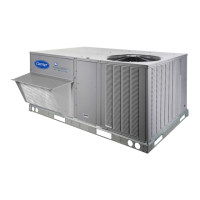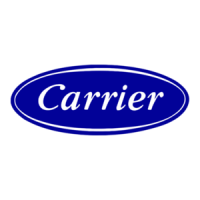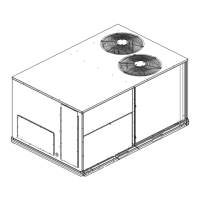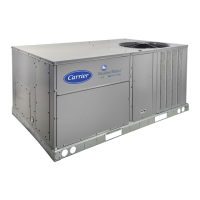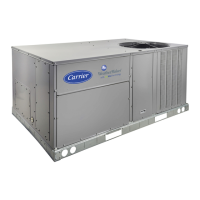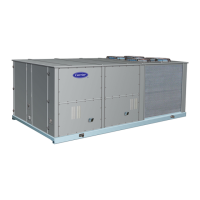21
Reheat Mode Diagnostic Help
The status of reheat mode sensor inputs may be viewed within the
display INPUTS menu. The status of reheat mode outputs may be
viewed within the display OUTPUTS or RUN STATUSMODE
menu. Additional diagnostic help, including status of circuit reheat
temperature limit lockouts may be viewed within the
Humidi--MiZer sub--menu of the cooling mode diagnostic table at
RUN STATUSCOOLDEHUMIDIFICATION.TheService
Test mode may be used to force the system to operate
Dehumidification mode (Hot Gas Reheat) and Dehum/Mech
Cooling mode (Subcooling), or to independently operate the reheat
valve control outputs.
The following forced operating states are available service test
operations for a Humidi-- MiZer system equipped unit:
SER VI CE TEST COOL TEST HUMIDIMI ZER TEST
A value of “0” sets reheat control test to “Off.”
SER VI CE TEST COOL TEST HUMIDIMI ZER TEST
A value of “1=SUBCOOL” sets Humidi--MiZer control test to
“D ehum/M ech Cooli ng mode (S ubcooli ng).”
SER VI CE TEST COOL TEST HUMIDIMI ZER TEST
A val ue of “2= REHEAT” se ts Humidi--MiZer te s t to
“Dehumidification mode (Hot Gas Reheat).”
SER VI CE TEST INDEPENDENTS RH LIQ VAL VE TEST
A value of “ On” wi l l turn on the Rehe at Liqui d Valve (RLV).
SER VI CE TEST INDEPENDENTS RH DIS VALVE TEST
A value of “ On” wi ll turn on the Re heat Discharge Valve (RD V).
SER VI CE TEST INDEPENDENTS CL LIQ VALVE TEST
A value of “ On” wi ll turn on the Cool i ng Liquid Valve (R DV ).
Indoor Fan B ased Dehumidification
Units that are not factory configured for Humidi-- Mizer operation
can be set for improved dehumidification operation through fan
based humidification (FBD), SETTINGS
UNIT
CONFIGURATIONS
COOLING
FAN BASED DEHUM
FBD CONTROL TYPE. Units are factory defaulted to FBD
CONTROL TYPE = 0 which means that any dehum demand is
ignored. There are two fan based dehumidification options, Max
Comfort (FBD CONTROL TYPE = 1)andMax
Dehumidification (FBD CONTROL TYPE = 2). Fan based
dehumidification requires the installation and configuration of
either a space relative humidity sensor or a relative humidity switch
input.
Max Dehum
Whe n the FBD Type is se t to (2) Ma x Dehum , the cont rol will try to
satisfy the dehumidification demand. When the unit receives a dehum
dem and a PID control algorithm will modulate the indoor fan while
the com pr ess or is running to mai nt ain mini mum suc tion temperature
(FBDH _SST) . The cool ing st ages wil l be cont roll ed as norma l
cooling dema nd requests, only the IDF wil l change for
dehumidification demand.
Max Comfort
When the FBD Type is set to (1) Max Comfort, the control will try
to satisfy the dehumidification demand and minimize cold air
dump. When the unit receives a dehum demand a PID control
algorithm will modulate the indoor fan while the compressor is
running to maintain the minimum FBD supply air comfort set
point (FBDH_SAT) while also maintaining the minimum suction
temperature (FBDH_SST). The cooling stages will be controlled as
norm al cooling demand requests, only the IDF wil l change for
dehumidification demand.
Heating Operation
The unit’s heating operation consists of: demand and mode
determination, staging request to satisfy the demand, and handling
a request with the unit’s resources. These resources can be gas heat
or electric heat. This section covers both gas heat units and electric
heat units. The Type of Heat Installed (UNIT TYPE OF HEAT )
configuration will be factory set to 1 for gas units and 0 for electric
heat units. The unit enters a heating mode based on a demand,
decides how to satisfy the demand, executes its plan, and then
leaves the heating mode.
Heating Mode Control
The heating HVAC mode (OPERATING MODE) has 3 different
operating sub modes (SUBMODE): HEATING, HEATING
PREVENTED, and SHUTTING HEAT OFF. These are all part of
a general heating mode and resemble the action heat mode is taking
at any given time. All types of heating are still performed under the
general heating function, and the expanded text is for user
reference only.
For the unit to be allowed to e nt er the he at mode, three things must be
true: the indoor f an must be ok to use, the mode changeover ti m e
guard must be expired, a nd there must be a heating dem and. The unit
will remain in heating for at least one minute and until the demand is
dropped or if any of the above conditions ar e false. The heating mode
does not officially end until all heat stages are off, the fan off delay has
expired, and the IGC fan request is dropped.
Supply--Air Temperature Sensor (SAT) Heat Mode
The SAT Heat Mode Sens ing (SAT DURING HEAT?) informs the
unit t hat the s upply air sensor is valid during hea ting in its c ur rent
location. This conf iguration affe cts the Supply Air Te m pe rature
(SUPPL Y AIR TEMP) value displayed as listed below .
When SAT DURING HEAT? is disabled, the Supply Air
Temperature (SUPPLY AIR TEMP) value on the SystemVut
display and the network will hold a zero when heat outputs come
ON and for 5 minutes after .
When SA T DURING HEAT? is enabled, the Supply Air Temperature
(SUPPL Y AIR TEMP) sensor reading is displayed at the SystemVu
controll er and network during he ating mode.
Heating Staging Control
Once the unit is in a heating mode, it determines what the demand
is and how to satisfy it. Requested Heating Stages (REQ. HEAT
STAGES) will be determined then passed to heat control to
actually add the heating stages. To request stages the number of
heat stages (HEATING STAGE QTY) must be greater than zero.
As a gas unit this will be set in the factory, however 50GC units
may have heat installed as accessories. If the Outdoor Air
Temperature (OUTDOOR AIR TEMP) is greater than the Heating
Lockout Temp (HEAT LOCKOUT OAT), all the heat stages will
be locked out (HEAT LOCKOUT).
There are two ways of requesting stages when thermostat control is
enabled, traditional thermostat control or adaptive control.
Traditional thermostat control is used if set for non--adaptive
thermostat (ADAPTIVE TST AT = NO). If se t for ada ptive the rmostat
(ADAPTI VE TSTAT = YES), the unit will use adaptive control for
staging. When configured for space sensor or RAT control (UNIT
CONTOL TYPE) the unit will use adaptive control for staging.
With either staging method there are then two supply air
temperature limits, the Maximum SAT Lower Level (LOWER
MAX SAT) the Maximum SAT Upper Level (UPPER MAX SAT).
Any time the supply air temperature rises above lower level the
heat staging will be limited to what is currently on and no
additional stages will be added until the supply air temperature falls
back below the lower level. If the supply air temperature rises
above the upper level, then heating will be reduced by removing
one stage. That stage will not be added again until the Supply Air
Temperature falls below the lower level. If the supply air
temperature stays above the upper level, then another stage will be
removed. If the upper and lower levels are configured so that they
are close together, the last stage of heat might cycle rapidly, slowed
only by its minimum on and off--time requirements.
Adaptive Control
Stage timers and Supply air trend apply when determining the
request for stages. The first request (REQ. HEAT STAGES =1)
comes immediately when starting the staging process. The Heat

